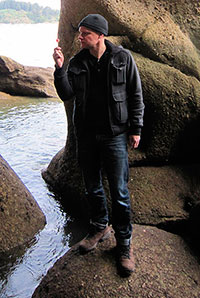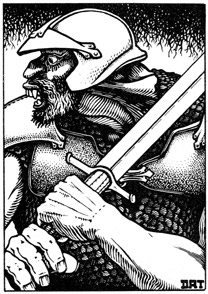08 Jan 13
 Happy new year, dear Headless Hollow readers!
Happy new year, dear Headless Hollow readers!
I start the new year with a link to a new article about me—yes, me, me, it’s all about me—it’s my blog after all, what did you expect? The folks over at the Tékumel Foundation have posted a short article asking me five questions about my involvement with Professor Barker’s wonderful creation, the world of Tékumel. Check it out!
If all this talk of something called Tékumel is a foreign language to you, then settle back and visit tekumel.com, the website I created back in 1997. If you’re a fan of world-building a la Tolkien, then you’ll find this uniquely non-Western take on imaginative fantasy to be right up your alley. And yes, he invented his own languages … Professor Barker sadly passed away last year, but his creation lives on, carefully managed by the aforementioned Foundation, and there are many plans to release old and new Tékumel material to the world. Hopefully this amazing work will begin to reach the wider audience it deserves.
Roleplaying Games interview, Tekumel
15 Oct 12
 If you, like me, spent a good chunk of your formative years pitting your friends against horrific monsters, sending them into dank dungeons, inflicting damage, disease and insanity upon them, and generally acting like God on (Middle-) Earth, then I hope you too were playing Dungeons & Dragons and aren’t instead a rank psychopath now paying for your terrible crimes. A lot of people born in the sixties and seventies were doing the same, or the subjects of similar imaginative abuse as adventuring characters in a fantasy, sci-fi or historical world. D&D, and the many roleplaying games it spawned, were a big fad of the late 70s and 80s; but a fad with a far bigger impact on people’s lives than twirling a hula–hoop or spinning a yo-yo. There’s been nothing quite like role-playing games, before or since, and anyone who spent any serious time playing them will understand what I mean.
If you, like me, spent a good chunk of your formative years pitting your friends against horrific monsters, sending them into dank dungeons, inflicting damage, disease and insanity upon them, and generally acting like God on (Middle-) Earth, then I hope you too were playing Dungeons & Dragons and aren’t instead a rank psychopath now paying for your terrible crimes. A lot of people born in the sixties and seventies were doing the same, or the subjects of similar imaginative abuse as adventuring characters in a fantasy, sci-fi or historical world. D&D, and the many roleplaying games it spawned, were a big fad of the late 70s and 80s; but a fad with a far bigger impact on people’s lives than twirling a hula–hoop or spinning a yo-yo. There’s been nothing quite like role-playing games, before or since, and anyone who spent any serious time playing them will understand what I mean.
Now I’m really, really late to the party (this whole thing kicked off about four years ago), but something called the OSR (‘Old School Renaissance’) is in full swing. Actually, in a way I was a bit of a pioneer personally and professionally in this respect, because I had a D&D nostalgia trip about ten years ago, when I re-bought the old books and adventure modules on Ebay that I’d so foolishly sold in my late 20s, thinking “I’d never play that stuff again.” And if I may present my other credential, I created the website The World of Tékumel back in 1997 to celebrate the first roleplaying game I ever played: Professor M.A.R. Barker’s The Empire of the Petal Throne. That’s about as old school as you can get.
Like most things that are an integral part of one’s formative years, D&D has a magic about it that never really goes away. My friends and I very, very occasionally get together to play Warhammer Fantasy Roleplay, a similar role-playing game set in the Empire of the Warhammer universe, but the original versions of D&D are a differently thing entirely, with a special atmosphere that the proponents of the OSR love to celebrate.
 We’re not talking about anything published ‘officially’ during the last couple of decades of increasing commercialisation and steadily encroaching blandness, of bad movies and cartoons and licenced toys, or of versions 2, 3, 3.5 (argh!), 4, and what is currently called D&D Next (triple argh!). We’re talking about three very early systems—the original ‘white box’ rules (just before my time), the old Basic Dungeons & Dragons sets (the original by J. Eric Holmes is where I came in—you can see the rulebook cover on the right), and the first edition Advanced Dungeons & Dragons hardcovers (‘AD&D’—the system I played the most). We’re talking everything up to about 1984, when the Dragonlance adventure modules came out and the original pulp science-fantasy origins of D&D began to be replaced by a kind of bland ‘American Tolkien’ fantasy melieu of buffed heroes, chainmail bikinis and Big Bad Guys. No, we’re talking getting a fighter, magic-user, cleric and thief together and descending into some monster-infested dungeon in search of gold pieces and magic items.
We’re not talking about anything published ‘officially’ during the last couple of decades of increasing commercialisation and steadily encroaching blandness, of bad movies and cartoons and licenced toys, or of versions 2, 3, 3.5 (argh!), 4, and what is currently called D&D Next (triple argh!). We’re talking about three very early systems—the original ‘white box’ rules (just before my time), the old Basic Dungeons & Dragons sets (the original by J. Eric Holmes is where I came in—you can see the rulebook cover on the right), and the first edition Advanced Dungeons & Dragons hardcovers (‘AD&D’—the system I played the most). We’re talking everything up to about 1984, when the Dragonlance adventure modules came out and the original pulp science-fantasy origins of D&D began to be replaced by a kind of bland ‘American Tolkien’ fantasy melieu of buffed heroes, chainmail bikinis and Big Bad Guys. No, we’re talking getting a fighter, magic-user, cleric and thief together and descending into some monster-infested dungeon in search of gold pieces and magic items.
A lot of other people remember these good old days before Hasbro bought everything in sight, and hence the OSR was born on scores of blogs across the internet. And small (one-personal small) publishers responded. There are now myriad cheap PDF rules sets and adventure modules taking you back to the days when fun was more important than plots, players—instead of their skill scores—decided what their character did, miniatures were pretty much non-essential but graph paper was, and characters died a lot (and were resurrected). Some of the best-known are Labyrinth Lord, a Basic D&D ‘retro-clone’ with a some companion rules to bring it up to an AD&D style; Swords & Wizardry, which keeps things nice and simple and is modelled after OD&D (‘Original D&D’); and OSRIC, an AD&D retro-clone. Other game systems of the period are getting their time in the sun too: Mutant Future (similar to the old post-apocalyptic RPG Gamma World), Stars Without Number and Thousand Suns (Traveller)—the list goes on and on.
Most of the information I’ve soaked up about the OSR I’ve got from the the Grognardia blog by James Maliszewski, an extremely prolific commentator on the subject who seems to be one of the fathers of this particular renaissance. For people who grew up with the same stuff as me, it’s a wonderful trip down memory lane as he examines old role-playing game books, advertisements in Dragon magazine, the sad and messy history of TSR (the company that published D&D), and some obscure pulp science-fiction and fantasy literature as well. I’m almost ashamed to admit that I recognise almost every old advertisement and every old illustration. Another great blog is Fighting Fantasist, whose particular obsession is old school English fantasy from the same period, especially early Games Workshop, way back before the shareholders and the lawyers called the shots and you could still buy a miniature figure for a couple of bucks.
 The defining visuals of the OSR are the original illustrators, many of whom are enjoying their own personal resurgence in popularity. Old school artists like Jim Roslof and David C. Sutherland (both, sadly, recently passed away), Russ Nicholson, David Trampier (a personal favourite—that’s his wonderfully graphic work on the left), Erol Otus, Jeff Easley, Jim Holloway and others are finding their somewhat naive but hugely evocative styles once more in vogue. OSR gamers are sick of the lifeless, ‘realistic’ perfection that passes for game art these days, and enjoy this old style of art that is so full of personal style and character. The new Dungeon Crawl Classics Role Playing Game, in particular, features an impressive roll-call of these classic artists, who quite literally defined the imaginative worlds of a generation of gamers. Even back then as a kid, I knew who these guys were and recognised each of their styles—who could say the same about most of the generic art pumped out by big game companies these days?
The defining visuals of the OSR are the original illustrators, many of whom are enjoying their own personal resurgence in popularity. Old school artists like Jim Roslof and David C. Sutherland (both, sadly, recently passed away), Russ Nicholson, David Trampier (a personal favourite—that’s his wonderfully graphic work on the left), Erol Otus, Jeff Easley, Jim Holloway and others are finding their somewhat naive but hugely evocative styles once more in vogue. OSR gamers are sick of the lifeless, ‘realistic’ perfection that passes for game art these days, and enjoy this old style of art that is so full of personal style and character. The new Dungeon Crawl Classics Role Playing Game, in particular, features an impressive roll-call of these classic artists, who quite literally defined the imaginative worlds of a generation of gamers. Even back then as a kid, I knew who these guys were and recognised each of their styles—who could say the same about most of the generic art pumped out by big game companies these days?
But there’s no future in wallowing in nostalgia, and those enamoured of the OSR, while understandably enjoying revisiting the vivid fantasies of childhood, are also looking to the future. New games are coming out that marry old approaches to gaming to simpler mechanics—for example the aforementioned DCC RPG. The idea is to tear roleplaying back out of the grasp of corporations and companies that want gamers to stay within the boundaries of the worlds they market and sell. Not to mention making roleplaying games playable again for those of us with families, mortgages and a frightening dearth of the endless spare time we had as teenagers. Roleplaying used to be about freedom to imagine anything. Care for a bit of science-fiction mixed in with your fantasy? Go for it. Don’t like the game worlds the companies have invented? Invent your own. Things in your imagination are inconsistent and ‘unrealistic’? Who cares! The important thing is to not worry about the rules so much: make it up as you go along, make a ruling on the spot, roll a dice on a table of random results. For someone like me, who has long been obsessed with preparing games long past the point of necessary effort, it’s a liberating return to the original goals of getting a few people together and making up stories in your collective imagination.
So if you’re getting a bit sick of the rules and restrictions, give the OSR a try. As I write, we’re gathering a party of adventurers, mixing old school rules and sensibility with the convenience of modern internet video conferencing technology, and descending into the Barrowmaze. How many will come out again—well, that remains to be seen …
Roleplaying Games D&D, Tekumel
22 Apr 05

If you examine the amazing detail that Tolkien put into his imaginary world of Middle-earth, and how it has sparked the imaginations of millions for a generation—you’d be forgiven for thinking that this creation is unique in its complexity. But there is another world, less well known but just as complex, multi-hued, and co-incidently also the life’s work of a professor of linguistics. His name is Professor M. A. R. Barker, and the world is called Tékumel (tay-koo-mayl). I first became interested in this place in my early teens, when it was the subject of a now-classic roleplaying game called The Empire of the Petal Throne. It came out about the same time as Dungeons & Dragons, but far from the kind of generic Tolkienesque style of that game, it was a fully developed, decidedly non-Western melieu of original fantasy.
I forgot about it for about fifteen years, and then stumbled across one of Professor Barker’s novels (there are five so far) set on Tékumel in a second-hand bookstore. The vividness of Tékumel came flooding back, and I decided to give this world a website, a home on the internet. That was almost eight years ago, and Tekumel: The World of the Petal Throne has grown into a site of some 290 pages that is not only a repository for online versions of material dating back to 1975, but a place where you can spend many, many hours reading about this amazing world and the people, societies and creatures that live on it. I’ve just re-launched the site and it has been improved in every way. If you like imaginary worlds, you are in for a big treat—welcome to Tékumel!
Roleplaying Games Tekumel
 Happy new year, dear Headless Hollow readers!
Happy new year, dear Headless Hollow readers!
 If you, like me, spent a good chunk of your formative years pitting your friends against horrific monsters, sending them into dank dungeons, inflicting damage, disease and insanity upon them, and generally acting like God on (Middle-) Earth, then I hope you too were playing Dungeons & Dragons and aren’t instead a rank psychopath now paying for your terrible crimes. A lot of people born in the sixties and seventies were doing the same, or the subjects of similar imaginative abuse as adventuring characters in a fantasy, sci-fi or historical world. D&D, and the many roleplaying games it spawned, were a big fad of the late 70s and 80s; but a fad with a far bigger impact on people’s lives than twirling a hula–hoop or spinning a yo-yo. There’s been nothing quite like role-playing games, before or since, and anyone who spent any serious time playing them will understand what I mean.
If you, like me, spent a good chunk of your formative years pitting your friends against horrific monsters, sending them into dank dungeons, inflicting damage, disease and insanity upon them, and generally acting like God on (Middle-) Earth, then I hope you too were playing Dungeons & Dragons and aren’t instead a rank psychopath now paying for your terrible crimes. A lot of people born in the sixties and seventies were doing the same, or the subjects of similar imaginative abuse as adventuring characters in a fantasy, sci-fi or historical world. D&D, and the many roleplaying games it spawned, were a big fad of the late 70s and 80s; but a fad with a far bigger impact on people’s lives than twirling a hula–hoop or spinning a yo-yo. There’s been nothing quite like role-playing games, before or since, and anyone who spent any serious time playing them will understand what I mean. We’re not talking about anything published ‘officially’ during the last couple of decades of increasing commercialisation and steadily encroaching blandness, of bad movies and cartoons and licenced toys, or of versions 2, 3, 3.5 (argh!), 4, and what is currently called D&D Next (triple argh!). We’re talking about three very early systems—the original ‘white box’ rules (just before my time), the old Basic Dungeons & Dragons sets (the original by J. Eric Holmes is where I came in—you can see the rulebook cover on the right), and the first edition Advanced Dungeons & Dragons hardcovers (‘AD&D’—the system I played the most). We’re talking everything up to about 1984, when the Dragonlance adventure modules came out and the original pulp science-fantasy origins of D&D began to be replaced by a kind of bland ‘American Tolkien’ fantasy melieu of buffed heroes, chainmail bikinis and Big Bad Guys. No, we’re talking getting a fighter, magic-user, cleric and thief together and descending into some monster-infested dungeon in search of gold pieces and magic items.
We’re not talking about anything published ‘officially’ during the last couple of decades of increasing commercialisation and steadily encroaching blandness, of bad movies and cartoons and licenced toys, or of versions 2, 3, 3.5 (argh!), 4, and what is currently called D&D Next (triple argh!). We’re talking about three very early systems—the original ‘white box’ rules (just before my time), the old Basic Dungeons & Dragons sets (the original by J. Eric Holmes is where I came in—you can see the rulebook cover on the right), and the first edition Advanced Dungeons & Dragons hardcovers (‘AD&D’—the system I played the most). We’re talking everything up to about 1984, when the Dragonlance adventure modules came out and the original pulp science-fantasy origins of D&D began to be replaced by a kind of bland ‘American Tolkien’ fantasy melieu of buffed heroes, chainmail bikinis and Big Bad Guys. No, we’re talking getting a fighter, magic-user, cleric and thief together and descending into some monster-infested dungeon in search of gold pieces and magic items. The defining visuals of the OSR are the original illustrators, many of whom are enjoying their own personal resurgence in popularity. Old school artists like
The defining visuals of the OSR are the original illustrators, many of whom are enjoying their own personal resurgence in popularity. Old school artists like 
Recent Comments